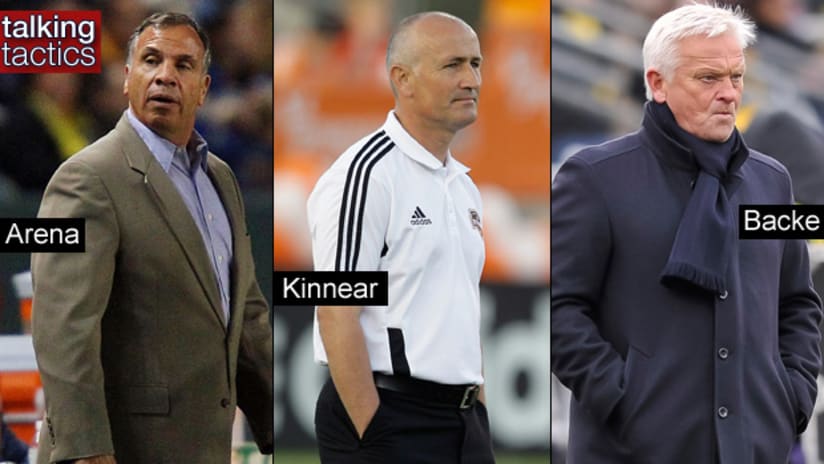Tactics at their core are about getting the best from available personnel. In Week 3, three coaches — LA’s Bruce Arena, Houston’s Dominic Kinnear, and New York’s Hans Backe — demonstrated how one alteration can make all the difference.
The Central Theme
At The Home Depot Center on Saturday night, Arena had to change things up. The Galaxy were coming of an embarrassing 4-1 defeat at Real Salt Lake and were facing the gritty Philadelphia Union. They needed to generate more offense.
[inlinenode:332895]The Galaxy attack in the past could sometimes be overly dependent on Beckham’s long, diagonal balls from the right, many aimed at Landon Donovan. It’s been tough to tell much about the preferred Galaxy way forward this year due to Juan Pablo Angel’s inconsistent availability and because conditions have been wet and difficult. (Also because the Galaxy ran up against a buzz saw in highly motivated Real Salt Lake in one of those.)
Ángel generally is not a player seeking to outrace defenders to Beckham’s long-range efforts. Rather, he’ll check back, hoping to involve others. That requires better possession than the Galaxy have shown with Chris Birchall as the initial distributor in the middle of their 4-4-2. So Arena swapped Birchall and David Beckham, pulling the latter out of his preferred operating space on the right and placing him centrally.
Beckham’s ability to keep possession (along with the underrated Juninho, of course) and keep plays alive significantly improved LA’s attack. No, Birchall isn’t Beckham out wide, but the Galaxy’s extra possession helped mitigate the Trinidadian international’s limited offensive capacity.
You might think Birchall would have tucked inside more often, offering to do a little more of the defensive heavy lifting for Beckham. But he remained fairly true to the right side. In fact, with right back Sean Franklin aggressively pushing forward, and with Beckham’s natural propensity to drift right, the Galaxy attack tended to be tilted to that side.
Otherwise, the Galaxy midfield operated as usual. Beckham and Juninho started defensively side-by-side, and in possession Juninho scooted forward, leaving Beckham to create and distribute.
Clearly, Beckham can’t cover tons of ground defensively, nor does he close as quickly as other natural holding midfielders in the league. Shalrie Joseph, he ain’t. But he does see the game pretty well, so his awareness of where and when to challenge helps a lot. Most importantly, it worked against Philadelphia.
[inlinenode:330075]Speed Kills Speed
In New York, Houston manager Dominic Kinnear made an interesting choice in asking midfielder Corey Ashe to play left back. It was all about dealing with the speed of Red Bulls’ winger Dane Richards, who has ripped up the Dynamo defense in the past. For the most part, Ashe matched Richards step for step. The Red Bulls’ fleet wide man only rarely found space behind the defense, and when he did, Ashe always had the foot speed to recover.
It makes you wonder why other teams don’t try a similar tactic against New York: Put your fastest man at left back, canceling out Richards’ main weapon. Once speed is no longer a factor, it falls to Richards to muster the skill and/or the creativity to be effective down the flank, something he is not always capable of.
[inline_node:332740]Counter Moves
But Richards does not play in solitude. Part of his difficulty against Ashe and the Dynamo stemmed from the Red Bulls’ inability to get him the ball in the right situations.
So coach Hans Backe made two halftime adjustments in response to his counterpart’s tactical maneuvers. First, in came newly acquired Dwayne De Rosario for an ineffective Mehdi Ballouchy, playing in the hole behind strikers Thierry Henry and Juan Agudelo. Second, he redirected Richards’ path forward toward the middle.
De Rosario’s insertion paid immediate dividends. He fed Richards for the home team’s only goal. In the bigger picture, it will take some time for De Rosario to precisely locate the available spaces. Joel Lindpere on the left tends to drift inside to assist Teemu Tainio in the middle. Richards typically stays wide on the right; since he’s the Red Bulls' only natural “wide” player, the midfield is a bit unbalanced.
But for the second half Saturday, Backe had a solution for the Ashe blanket. He instructed Richards to forgo some width and asked him to dart inside to look for balls from De Rosario or Lindpere. It worked well, requiring Ashe to make decisions he clearly wasn’t comfortable making: when to follow his man, when to pass off responsibility, etc.
Richards’ goal came on one of those runs from the right across the back line. Richards was behind the two center backs when he latched onto De Rosario’s pass. The goal is not necessarily Ashe’s fault—though he does have to communicate the movement—but obviously Richards’ inside running proved decisive.
Meanwhile, that running also allowed Agudelo or right back Jan Gunnar Solli to enter the space Richards created by going inside, forcing more choices on Ashe. There were times when Ashe seemed lost in thought — never ideal for a defender. Only another outstanding night from Houston goalkeeper Tally Hall prevented a match-winner from the home team.
Steve Davis's "Talking Tactics" appears exclusively on MLSsoccer.com every Tuesday.





